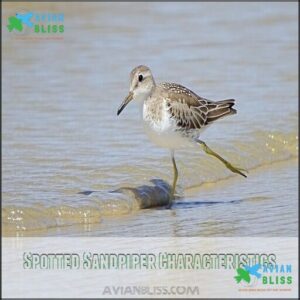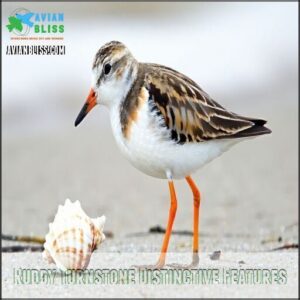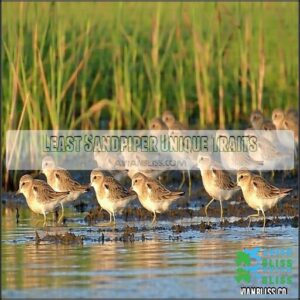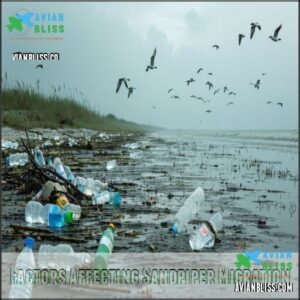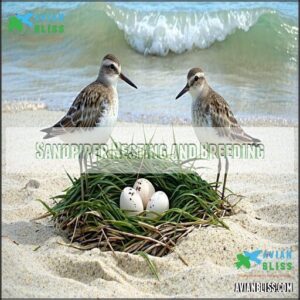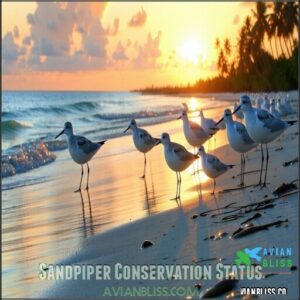This site is supported by our readers. We may earn a commission, at no cost to you, if you purchase through links.

Common species include the Spotted Sandpiper, known for its teetering walk, and the Sanderling, often chasing waves like a tiny surfer.
These birds migrate seasonally, with many arriving in Florida during fall and winter, and their diet mainly consists of insects, small crustaceans, and marine worms, which they expertly forage using their slender bills.
Unfortunately, habitat loss and climate change threaten their populations, making it essential to understand their behaviors and habitats to help protect these fascinating shorebirds for generations to come.
Table Of Contents
- Key Takeaways
- Sandpiper Species Found
- Sandpiper Migration Patterns
- Sandpiper Diet and Foraging
- Sandpiper Nesting and Breeding
- Sandpiper Conservation Status
- Frequently Asked Questions (FAQs)
- What kind of sandpipers live in Florida?
- What is the difference between a spotted sandpiper and a common sandpiper?
- What are the little birds that run on the beach in Florida?
- What is special about sandpipers?
- Are there sandpipers in Florida?
- What does a spotted sandpiper do?
- Where do sandpipers live?
- What does a sandpiper look like?
- How many types of sandpipers are there in North America?
- Are spotted sandpipers still common?
- Conclusion
Key Takeaways
- You’ll spot sandpipers like Sanderlings and Spotted Sandpipers along Florida’s beaches and wetlands, showcasing unique behaviors like wave-chasing and teetering walks.
- These shorebirds rely on Florida’s coastlines for feeding, nesting, and migration, with diets including insects, crustaceans, and marine worms.
- Habitat loss, coastal development, and climate change threaten sandpipers, making conservation efforts like protecting wetlands and reducing pollution essential.
- Sandpipers exhibit fascinating traits like the Spotted Sandpiper’s role-reversing courtship and the Ruddy Turnstone’s stone-flipping foraging technique.
Sandpiper Species Found
You’ll find five prominent sandpiper species along Florida’s diverse shorelines and wetlands, including the distinctive Spotted Sandpiper with its characteristic teetering motion and the quick-footed Sanderling that races the incoming surf.
Each species exhibits unique physical traits and behaviors that you can observe throughout different seasons, with some remaining year-round while others visit during specific migration periods.
Spotted Sandpiper Characteristics
You’ll recognize the Spotted Sandpiper by its distinctive teetering behavior as it walks along Florida’s shorelines.
The Spotted Sandpiper’s unique teetering walk adds charm to Florida’s shorelines, making it a delightful sight for birdwatchers.
At 8 inches tall with a brown head, white throat and underbelly, this solitary shorebird doesn’t typically form flocks.
Its flight pattern features rapid wingbeats with stiff-winged glides close to water, and juvenile markings differ slightly from adults.
Their diet includes insects, crustaceans, and small fish they pick from shallow waters.
Sanderling Identification and Habitat
Sanderlings, those small brown shorebirds, can be spotted along Florida coasts from August through April.
You’ll identify these 8-inch Florida shorebirds by their Winter Plumage—light gray above and white below.
During Coastal Flocking, they gather in groups up to 20 birds, racing along beaches with their distinctive Surf Foraging behavior.
They spend winters in Florida before migrating to Arctic Breeding grounds.
Juvenile Identification relies on their slightly scalloped back pattern.
Ruddy Turnstone Distinctive Features
You’ll spot the Ruddy Turnstone by its distinctive appearance among Florida shorebirds.
This stocky build sandpiper species in Florida stands out with:
- Orange legs that contrast sharply with beach sand
- Short bill perfectly designed for stone flipping behavior
- Calico patterning that resembles a miniature beach mosaic
- Compact 6-8 inch frame with a 20-inch wingspan
These coastal wintering birds are common Florida sandpipers from August through April, known for their calico patterning.
Least Sandpiper Unique Traits
While Ruddy Turnstones flip stones for food, another fascinating Florida visitor awaits your discovery.
The Least Sandpiper, North America’s smallest sandpiper species, prefers wetland habitats with grassy edges.
You’ll often find these tiny birds flock foraging in coastal wetlands across Florida.
They utilize a probing feeding technique to find food in the mud.
| Feature | Description | Identification Tip |
|---|---|---|
| Size | Smallest Sandpiper (5-6") | Smaller than a sparrow |
| Color | Brown above, white below | Yellow-green legs |
| Habitat | Grassy edges of wetlands | Away from surf line |
| Behavior | Forages in small flocks | Rapid, nervous feeding |
The key characteristics of the Least Sandpiper, such as its small size and rapid feeding behavior, make it a unique and interesting species to observe.
Its preference for grassy edges of wetlands and coastal wetlands provides opportunities for birdwatchers to spot it in its natural habitat.
Sandpiper Migration Patterns
You’ll witness sandpipers arriving along Florida’s coastlines from August through April as they migrate between Arctic breeding grounds and southern wintering areas.
Most species, including Sanderlings and Short-billed Dowitchers, follow predictable migration patterns influenced by seasonal changes, food availability, and weather conditions, which can be considered predictable.
When Do Sandpipers Arrive in Florida
Now that you’re familiar with Florida’s sandpiper species, let’s mark your calendar for their arrival. Most sandpipers begin appearing on Florida shores in August, with peak season occurring from September through April.
Weather influence can shift arrival timing slightly each year.
Florida birdwatching enthusiasts should note these regional differences:
- Sanderlings arrive August-April
- Ruddy Turnstones winter along the coast
- Spotted Sandpipers maintain year-round presence in some areas, which is an important factor for year-round birdwatching.
Where Do Sandpipers Migrate to in Winter
Florida’s sandpipers follow diverse migration routes when winter calls.
Western Sandpipers head to Central and South America, with hundreds of thousands wintering along Mexico and Panama’s Pacific coasts.
Semipalmated Sandpipers make remarkable non-stop flights of nearly 2000 miles to South American winter habitats.
Other species cross major ecological barriers including oceans, mountains, and tropical forests during their journey, traveling up to 20,000 km annually between breeding and winter habitats.
How Long Do Sandpipers Stay in Florida
Throughout their wintering duration, sandpipers in Florida display varied stopover lengths depending on species.
Sanderlings arrive in August and remain until April, making Florida their home for nearly eight months. Most shorebird migration patterns show that species like the Ruddy Turnstone typically winter along Florida’s coasts for similar extended periods.
You’ll notice seasonal abundance peaks during mid-winter, when these migratory birds establish temporary territories. The lengthy stay allows Florida birds to fully replenish before their demanding return to Arctic breeding grounds.
These staging sites are essential for the birds to accumulate fat reserves.
Factors Affecting Sandpiper Migration
Sandpipers’ time in Florida isn’t guaranteed.
Weather patterns, climate change, and habitat loss substantially impact their migration schedules.
Food availability dictates when they arrive and depart, while pollution affects their stopover duration.
Coastal development disrupts traditional migration routes, forcing shorebirds to find alternative paths.
Rising sea levels from climate change threaten essential mudflats and beaches where these migratory birds rest and refuel during their incredible journeys through Florida, which are influenced by climate change.
Sandpiper Diet and Foraging
You’ll observe sandpipers in Florida extracting small crustaceans, insects, and mollusks from the sand using their specialized bills, often running alongside receding waves to maximize feeding opportunities.
Each sandpiper species employs distinct techniques, from the Sanderling’s rapid probing between waves to the Ruddy Turnstone’s habit of flipping over stones and debris to uncover hidden prey.
The variety of techniques used by these birds highlights their adaptability and unique characteristics, such as the Ruddy Turnstone’s ability to find food in different environments.
What Do Sandpipers Eat in Florida
Down among the shallow waters of Florida’s coastline, you’ll find sandpipers feasting on a diverse menu of Florida invertebrates.
Their diet consists primarily of coastal crustaceans like sand crabs, beach hoppers, and small hermit crabs.
You’ll also notice species-specific diet adaptations—Spotted Sandpipers prefer aquatic insects, while Western Sandpipers consume biofilm, a slimy substance formed by microorganisms on intertidal sediments, comprising up to half their nutritional intake.
How Do Sandpipers Hunt for Food
When you watch sandpipers hunt for food along Florida’s shores, you’ll notice their remarkable prey detection abilities.
These shorebirds use specialized probing techniques, inserting their bills into sand to locate hidden invertebrates. Their exceptional visual acuity helps them spot tiny movements in the substrate.
Tidal influence often dictates their foraging patterns, with some species demonstrating cooperative hunting behaviors during low tide when more feeding areas become exposed.
Some species, like the Baird’s Sandpiper, undertake epic migrations across continents, showcasing their remarkable ability to travel long distances.
Sandpiper Feeding Habits and Techniques
You’ll frequently observe distinctive feeding techniques when watching sandpipers on Florida’s shores.
Distinctive feeding techniques of sandpipers reveal their adaptability, from wave-chasing Sanderlings to stone-flipping Ruddy Turnstones along Florida’s shores.
Each species has developed specialized foraging strategies based on bill morphology and habitat influence:
- The Spotted Sandpiper teeters constantly while picking insects and crustaceans from shallow water
- Sanderlings perform their characteristic "wave chase," running in and out with the surf
- Ruddy Turnstones literally flip stones and debris to uncover hidden invertebrates
These dietary adaptations maximize prey selection and foraging efficiency among shorebirds, which is a result of their distinctive feeding techniques.
Impact of Human Activity on Sandpiper Diet
While sandpipers have developed specialized feeding techniques, human activities substantially threaten their dietary patterns.
You’ll notice habitat destruction and shoreline manipulation have reduced critical feeding grounds, directly causing food scarcity.
Baitworm harvesting in coastal areas diminishes available prey, while pollution impacts create prey contamination issues.
Plastic ingestion is becoming increasingly common in Florida bird habitats, compromising sandpiper diet.
Recent sandpiper diet analysis shows these birds must adapt their foraging behaviors when human presence increases, often resulting in less efficient feeding. You can find a shorebird diet guide online for more information.
Sandpiper Nesting and Breeding
You’ll observe several sandpiper species nesting along Florida’s coastal areas, with the Spotted Sandpiper displaying unique breeding behaviors where females mate with multiple males who then incubate the eggs.
Most sandpipers construct simple ground nests lined with grass and moss near water bodies.
Their young typically leave the nest shortly after hatching to forage independently under parental supervision.
Where Do Sandpipers Nest in Florida
While exploring Florida’s wetland bird habitats, you’ll find diverse sandpiper nesting locations throughout the state.
Due to coastal development, many nesting habitats are now restricted to protected areas.
- Coastal beaches where eggs blend perfectly with sand
- Barrier islands offering sanctuary from predators
- Secluded spoil islands where nests remain undisturbed
- Freshwater lakes where Spotted Sandpipers raise families
- Protected parks preserving critical nesting sites
Sandpiper Nesting Habits and Characteristics
Nesting habits vary, but most sandpipers prefer open nest sites near water, creating shallow scrapes lined with grass or moss.
Eggs, typically three to four, require an incubation period of about three weeks.
Parental care roles differ—some species share duties, while others rely on one parent, and chick development is rapid, ensuring survival in challenging environments.
Sandpipers belong to the Scolopacidae family, which was introduced in 1815, and is a key part of understanding these birds, with their unique characteristics and rapid development.
Female Spotted Sandpiper Courtship Displays
Unlike most birds, female Spotted Sandpipers take charge in courtship.
You’ll witness a fascinating role reversal as females aggressively defend territories and pursue multiple mates—a behavior called polyandry.
They’ll puff their chests, circle males, and make distinctive calls to attract partners.
After mating, females leave the males to handle incubation duties while they seek additional mates.
This unique mate selection process showcases remarkable bird behavior rarely seen in Florida’s shorebirds, highlighting a notable example of role reversal.
Sandpiper Breeding Season and Patterns
During breeding season, most sandpiper species follow distinct patterns that vary by location and species.
You’ll notice these fascinating behaviors if you observe closely:
- Males typically incubate eggs for 20-24 days while females may mate with multiple partners
- Chick development happens rapidly, with first flights occurring at 17-21 days
- Nesting locations range from coastal marshes to inland waterways
- Parental care duties often fall primarily to males
- Breeding success depends heavily on habitat quality and human disturbance levels
The behaviors and patterns of sandpiper species are fascinating to observe, especially considering the unique characteristics of each species.
Sandpiper Conservation Status
You’ll find several Florida sandpiper species currently face significant threats from habitat loss, climate change, and human disturbance, with some populations showing concerning decline trends over recent decades.
Conservation organizations actively monitor these shorebirds, establish protected beach areas, and implement restoration projects aimed at preserving essential feeding and nesting habitats throughout the state’s coastlines, which helps in conservation efforts.
Threats to Sandpiper Populations in Florida
While sandpipers create fascinating nesting habitats, they face serious threats throughout Florida.
Habitat loss from coastal development continues to shrink available shorelines, while pollution impacts their food sources.
Human disturbance from beach recreation often interrupts critical feeding times.
Climate change poses perhaps the greatest risk, with rising sea levels threatening to eliminate essential wetlands.
You’ll notice fewer sandpipers where beaches have been heavily developed or where extreme weather events have damaged coastal ecosystems, highlighting the impact of coastal development and climate change.
Conservation Efforts for Sandpipers
Protecting sandpipers requires action. Here’s how you can help:
- Support Habitat Preservation by advocating for Protected Areas in wetlands and coastal zones.
- Push for stricter controls on Coastal Development to safeguard nesting sites.
- Promote Pollution Reduction to keep waterways clean for shorebird conservation.
- Boost Public Awareness through Florida bird conservation programs, ensuring everyone values these important species.
You can support Florida habitat projects through various organizations.
Impact of Climate Change on Sandpipers
Climate change hits sandpipers hard, altering migration shifts, food availability, and nesting.
Rising sea levels and extreme weather shrink habitats, while higher temperatures disrupt ecosystems. For effective sandpiper conservation, understanding these impacts is key.
Phenological mismatches further threaten breeding success. Here’s a quick breakdown:
| Impact | Cause | Result | Conservation Need |
|---|---|---|---|
| Habitat Loss | Sea level rise | Reduced nesting areas | Habitat restoration |
| Food Availability | Temperature changes | Scarce resources | Protected feeding zones |
| Migration Shifts | Climate disruptions | Delayed movements | Monitoring migration |
| Extreme Weather | Storms, flooding | Damaged ecosystems | Resilient habitats |
The key to effective conservation is understanding the impacts of climate change, including habitat loss, food availability, and extreme weather events, which all play a crucial role in the conservation of sandpipers.
Ways to Support Sandpiper Conservation
Climate change poses challenges, but you can make a difference for sandpiper conservation.
Help by supporting wetland conservation and migratory bird conservation efforts. Here’s how:
- Habitat Preservation: Advocate for protected coastal and wetland areas.
- Reduce Pollution: Limit plastic use and keep beaches clean.
- Support Research: Fund Florida bird conservation studies.
- Practice Responsible Tourism: Respect wildlife while enjoying coastal spaces.
Consider supporting wetland conservation initiatives to further aid these efforts.
Frequently Asked Questions (FAQs)
What kind of sandpipers live in Florida?
You’ll find several sandpipers in Florida, including Sanderlings, Spotted Sandpipers, Least Sandpipers, and Western Sandpipers.
They frequent beaches, wetlands, and mudflats, often foraging in flocks or darting along the surf for food.
What is the difference between a spotted sandpiper and a common sandpiper?
Picture a teetering Spotted Sandpiper versus a steady Common Sandpiper.
You’ll notice Spotted Sandpipers have bold breast spots in breeding season, while Common Sandpipers sport plain underparts.
Behaviorally, Spotted Sandpipers constantly bob their tails.
What are the little birds that run on the beach in Florida?
The little birds darting along Florida’s beaches are often Sanderlings.
These small shorebirds chase receding waves, probing the wet sand for crustaceans.
Their quick, scurrying movements and pale plumage make them easy to spot, with their behavior being a key aspect of identifying these birds as Sanderlings.
What is special about sandpipers?
Sandpipers are fascinating for their constant motion, unique teetering behavior, and specialized feeding techniques.
They adapt to diverse habitats, forage with precision, and display incredible migration journeys, often traveling thousands of miles between breeding and wintering grounds.
Are there sandpipers in Florida?
Yes, Florida hosts several sandpiper species, including Sanderlings and Least Sandpipers.
You’ll spot them along beaches, wetlands, and grassy edges, scurrying with the surf or foraging in flocks for tiny crustaceans and insects, which can be considered a key activity of foraging.
What does a spotted sandpiper do?
It’s like nature’s metronome—spotted sandpipers constantly teeter their tails while foraging near water.
You’ll see them snatch insects, crustaceans, or small fish, and when startled, they skim low over water with quick, stiff wingbeats, exhibiting a unique behavior that resembles a metronome.
Where do sandpipers live?
You’ll find sandpipers near water—coastal beaches, mudflats, marshes, or grassy wetlands.
They thrive along shores, foraging for food, but some species migrate inland to lakes and rivers, blending perfectly into these watery habitats.
What does a sandpiper look like?
You’ll recognize a sandpiper by its medium size, slightly tapered body, longish tail, and rounded breast.
They often lean forward, sport earthy tones, and display unique behaviors like teetering or darting along shores and wetlands, which can also include teetering.
How many types of sandpipers are there in North America?
Over 40 sandpiper species roam North America, each with unique traits.
From the teetering Spotted Sandpiper to Sanderlings chasing waves, you’ll spot them near coasts, wetlands, and lakes, showcasing nature’s incredible diversity.
Are spotted sandpipers still common?
Yes, spotted sandpipers remain common across North America, especially near water bodies.
You’ll notice their signature teetering motion along shores, streams, and ponds.
They’re adaptable and thrive in varied freshwater habitats during summer months.
Conclusion
From sandy beaches to marshy wetlands, sandpipers in Florida showcase unique behaviors, from teetering walks to wave-chasing sprints.
These shorebirds rely on Florida’s habitats for migration, feeding, and nesting, expertly foraging for insects and crustaceans.
However, threats like habitat loss and climate change endanger their survival.
By understanding their migration patterns, diet, and nesting habits, you can help protect these fascinating birds.
Supporting conservation efforts guarantees future generations enjoy Florida’s vibrant sandpiper species.

